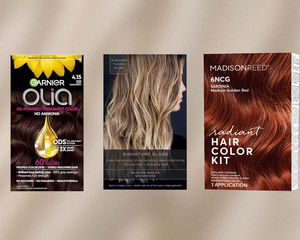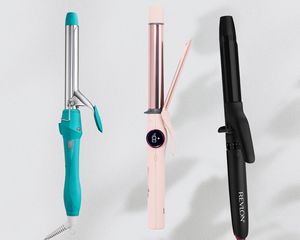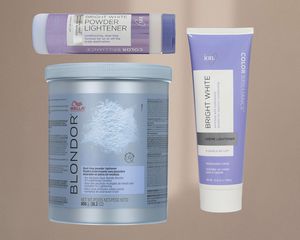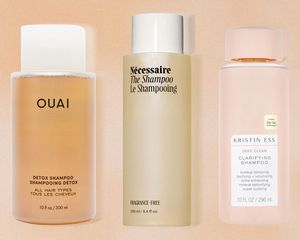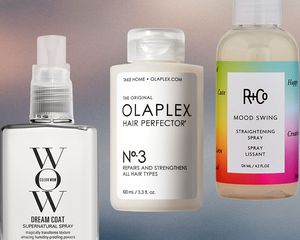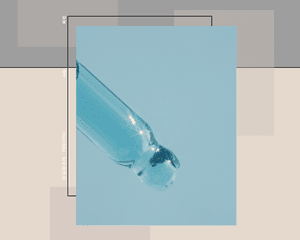:max_bytes(150000):strip_icc()/promo-5c3b027fd720447191707d81b9e3cf9f.jpg)
Stocksy
Fact: Grey, thinning, shedding hair is a natural part of aging. Whether it stems from transitional phases of life (re: childbirth and menopause), stress, or traumatic hair styling from your 20s and 30s, there's a laundry list of reasons as to why you may be experiencing what feels like a sudden change to your once-lustrous hair. And while there's nothing inherently wrong with aging (or the hair changes that comes along with it), many people find themselves yearning for ways to revive their strands. Thankfully, there is ways to bring your hair back to its full potential.
To learn about what causes age-related hair changes as well as what we can do help out our strands, we called on board-certified psychiatrist Sophia Kogan, celebrity hairstylist Irinel de Leon, professional hairdresser Nate Rosenkranz, and double board-certified facial plastic and reconstructive surgeon Dr. Michael Bassiri-Tehrani. If you've hit 40 and are struggling with an increase in post-shower hair shedding, thinner ponytails, and generally lackluster strands, you're in the right place. Keep reading to find out how to get amazing hair after 40.
Meet the Expert
- Sophia Kogan, MD, is the Co-founder and Chief Medical Officer of Nutrafol.
- Irinel de Leon is a celebrity hairstylist and natural hair expert based in L.A. She is also a brand ambassador for Ouidad.
- Nate Rosenkranz is a professional celebrity hairdresser based in New York City. He has done looks for editorial, television, and NYFW.
- Michael Bassiri-Tehrani, MD, is a double board-certified Facial Plastic and Reconstructive Surgeon.
Is It Normal for Hair to Thin in Your 40s?
The short answer is yes. The long answer is a bit more complicated. "As we age, our bodies undergo numerous changes, including shifts in hormone levels," says Dr. Michael Bassiri-Tehrani. "For women, the approach of menopause brings a decrease in estrogen and progesterone levels, which are crucial for maintaining hair growth. These hormonal changes can result in hair becoming finer and less dense. Additionally, the hair growth cycle slows down as we age, leading to a longer resting phase for hair follicles and shorter growth phases. This natural aging process, combined with potential genetic predisposition, makes hair thinning a common occurrence in the 40s."
How Can I Stop My Hair from Falling Out in My 40s?
If you've entered your 40s only to come face to face with brutal hair thinning, the good thing is, there are many different things you can do to address it. "Firstly, maintaining a healthy diet rich in vitamins and minerals is essential. Nutrients such as iron, zinc, and vitamin D play significant roles in hair health," says Bassiri-Tehrani. "Secondly, managing stress through practices like yoga, meditation, and regular exercise can reduce stress-induced hair loss." (More on that, below.)
According to Bassiri-Tehrani, chemical treatments and heat styling tools can also damage the hair, leading to hair thinning and hair loss. If you're dealing with hair loss, avoid these treatments and opt for hydrating and strengthening haircare products, serums, and supplements. While they won't work overnight, overtime, they can help to make your hair appear stronger and healthier.
"Lastly, consulting a healthcare provider to rule out underlying conditions such as thyroid problems or hormonal imbalances is crucial in addressing hair loss effectively," he adds.
Take Care of Your Scalp to Stimulate Hair Growth
We'll admit we tend to give every other part of our hair more attention than we do our scalp (namely, our split ends). That said, Sophia Kogan maintains that giving your scalp some TLC is an effective way to prevent the causes of hair thinning and promote hair growth. "Scalp health is dependent on internal factors like the balance of sex and stress hormones, as well as oxidative stress and gut health," she says. "That said, not washing your hair too frequently, avoiding color, harsh processing and chemicals, as well as massaging your scalp can all help to stimulate growth."
Use Ammonia-Free Hair Color to Avoid Damage
You've likely heard of ammonia in hair dyes before (it's what's used to open up the cuticle to prepare it for color deposit). However, according to Kogan, it has a higher pH, which can damage your scalp and the hair follicles, as well as compromise the structural integrity of your hair. Not to mention, the fumes can be harmful to breathe in.
"When talking to your stylist, ask about natural, organic hair dyes and avoid hydrogen peroxide, ammonia, ethanolamines and paraphenylenediamine (PPD)," advises Kogan. Luckily, many hair color brands, including Matrix, have altered their color formulas to be ammonia-free, which are less harmful for your hair and result in shinier, softer strands post-coloring.
Reduce Hair Loss By Avoiding Stress
Easier said than done, we know, but the hair follicle isn’t separate from your body, so how you treat the rest of your body directly affects your hair health. Kogan explains that hair damage from chronic stress can accumulate over time and contribute to a slow process of insidious hair shedding. Acute stress, on the other hand, is different. "When a major acute stressor occurs, it can cause a huge shift in our hormonal and neurochemical balance, which can signal a significant percentage of hair follicles to prematurely shift from the growth phase (anagen) to the resting phase (telogen)," explains Kogan. "During the telogen phase, hair is no longer able to grow and prepares to shed. As a result, you might see increased shedding, thinning around the temples, or hair falling out in large clumps at about three to six months after the stressful event occurs."
Be Gentle With Styling to Avoid Breakage
Those too-tight braids, extensions, and mile-high ponytails you sported as a 20-year-old could be the cause of the lackluster hair you're currently experiencing. "Your scalp is sensitive and prone to damage over time, so things like excessive rubbing, stretching and brushing can all damage your hair follicles and over time, cause irreversible hair loss," says hairstylist Irinel de Leon. "Tight hairstyles in your 20s and 30s can also lead to traction alopecia, which is totally preventable." Bottom line: be gentle with your strands today to avoid even more damage once you hit your 40s and beyond.
Use Moisture-Rich Products for the Hair and Scalp
Because there’s less sebum production coming from the scalp as we age, hair is prone to experiencing textural changes (think dryness and brittleness), especially post-menopause. To combat this, de Leon says to use moisture-rich products and stay away from anything too drying like clarifying shampoos. Also, our experts agree that harsh chemicals in everyday hair care products as well as over-styling from extreme heat can all contribute to hair damage. Opt for this stem cell-infused serum to support scalp hydration and promote fuller-looking hair.
Achieve Volume With the Right Products
"The best thing to do to achieve volume for fine or thinning hair is to start with the right products that are formulated to address your specific needs," notes celebrity hairdresser Nate Rosenkranz. To achieve volume, he says to start by shampooing with Alterna Haircare's Caviar Anti-Aging Clinical Densifying Shampoo, making sure to thoroughly clean the hair closest to the scalp where you want the volume to originate from. Rinse and add a small amount of Alterna Haircare's Caviar Anti-Aging Multiplying Volume Conditioner, avoiding the root to avoid adding any excess weight to the hair.
Then, blow dry your hair with a dryer that has a nozzle or “concentrator” to control the airflow. "The concentrator is the attachment that almost all hairdryers come with but very few people actually use when blowing out their hair at home," he says. "A concentrator focuses the stream of hot air and airflow onto a very small section, instead of letting it spread out." Dry the root first in the opposite direction that you want it to lay when your style is finished. "This will add maximum volume to your hair and help make styling the rest of your hair easier because the root will be dry already," says Rosenkranz.
Heal From the Inside Out
While it's tempting to slather on lotions and oils in hopes of healthier, stronger hair, both de Leon and Kogan explain that much of what makes hair healthy comes from within. "It’s important to realize that the health of the scalp and hair is not only affected by external factors, but also by the internal environment of the entire body—that’s why it’s important to take a holistic approach to healthy hair," says Kogan. "If you’re looking to try a supplement, Nutrafol Women and Women’s Balance Supplements contain saw palmetto to counter DHT (the hormone responsible for thinning hair), ashwagandha for increased stress, astaxanthin, a powerful antioxidant to fight oxidative stress from the environment and curcumin for immune balance."


